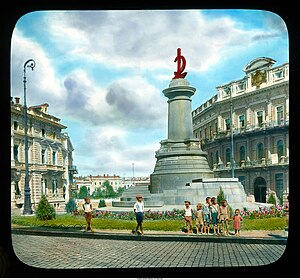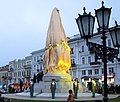Monument to the founders of Odesa
Monument to the founders of Odesa, also known as monument to Empress Catherine the Great of Russia and her companions: José de Ribas, François Sainte de Wollant, Platon Zubov and Grigory Potemkin. Located in Odesa on Ekaterininskaya Square. Built in 1900 by the project of Odesa architect Yuri Melent’evich Dmitrenko. Sculptor M. Popov, with the participation of sculptors B.V. Eduards, M.D. Mentsione,[1] engineer A. Sikorski. Dismantled in 1920. Restored in 2007 at the expense of the family of Ruslan Tarpan, Odesa businessman.
History of the monument
Construction
Catherine the Great by her rescript in 1794 launched the beginning of the construction of Odesa city and its port on the exact location of the Ottoman settlement Khadjibey.[2]
In gratitude for this Odessites in 1900 erected a monument to Catherine and her companions, who played an important role in the formation of young Odesa. Opening of the monument took place on May 6, 1900, in the eponymous square in the city center.
The prospect of building a Monument to the Founders of the city was offered as early as 1890 at a meeting of the City council on the subject of the celebration of the 100th anniversary of Odesa. On September 23, 1891 the Odesa City Council decided to establish a monument projects contest with two awards (two and one thousand rubles) for the best work. By May 1, 1892 the first prize was awarded to the project under the slogan "Odesa port" by Odesa architect Y. M. Dmitrenko, the second - under the slogan "Esperance" by foreign architect Donato Barkalaja. January 14, 1893, after the report by the Minister of Internal Affairs to the Emperor, Imperial permission followed to erect a monument to the Founders of the city to commemorate the 100th anniversary of Odesa. The estimates of the project amounted to 57 thousands rubles. Models of monument sculpture was manufactured by the professor, Imperial Academy of Arts (St. Petersburg) academician M.P.Popov, and works on building the foundations of a pedestal and casting of bronze figures themselves were commissioned to the sculptor B.V.Eduards and to the foreman of overall craft council of marble shop in Odesa Leopold Mentsione.[3][4]
Opening of the Monument to the Founders was accompanied by solemn ceremonies and citywide celebration, culminating in a fireworks.
Destruction
Three years after the October Revolution, in 1920, the monument was dismantled, under the dominant ideology of struggle against heritage the Czarist regime. Statues of Empress companions have been stored in the Odesa Museum of Regional History, and the figure of Empress herself was partially destroyed. In 1965, on the 60th anniversary of the uprising at the battleship "Potemkin" a monument to its sailors was built in this place.[5]
Reconstruction
First time the idea to restore the Catherine monument appeared in the late 1980s-early 1990s. Some fund-raising were organized. However, this ended with nothing. The first serious interest in his recovery took shape in 1995, when the Odesa City Council decided to restore the monument to the Founders of the city, at the same time using the preserved bronze fragments and adding the missing elements of the granite pedestal. However, these plans were stopped by the President of Ukraine Leonid Kuchma.[6] On July 2, 2007 for consideration of the Odesa City Council a draft decision named "On the complex restoration and improvement of Ekaterininskaya Square of Odesa city with reproduction of its historical type" was submitted. According to this decision, the monument to the sailors of the battleship "Potemkin" should be moved to the Customs Square, while the original monument should be reconstructed on Ekateriniskaya Square. By this decision of the City Council (#1401-V from 04.07.2007) a special commission was established to monitor the compliance of the restored monument with the lost original. The project sponsor and the customer of restoration works was City Council deputy Ruslan S. Tarpan.
Ruslan Tarpan: "The desire to restore Ekaterininskaya Square in all its beauty, visible on old postcards, appeared in my youth, that's why I acted as a customer and sponsor of the restoration of this monument. It was thorny, but exciting way for me. It was a matter of honor for me to restore it in that form in which it was at the beginning of the twentieth century, when in 1901 at the World exhibition in Paris, this Square was named as the best in Europe! "[7]
Honored architect of Ukraine Professor Vladimir Glazyrin was named as inspector general for all planned works.[8] Many preserved historical documents and photographs of those times were widely used during the reconstruction. Such as a watercolor sketch of the architect Yuri Dmitrenko "Odesa-port" project which won in 1892 competition. It was decided to reproduce everything like it was when the monument was opened a century ago, therefore the monument differs from the conceptual design of Dmitrenko. The only external difference from the original monument became four bronze plaques with the names of the Companions of Catherine.
The bronze figure of the Empress was made completely newly, because it seemed impossible to combine in color the head preserved in the museum with the rest of the created figure. According to the decision of Ruslan Tarpan, the customer of the reconstruction, a tender was announced for the casting of the Catherine bronze statue. It was won by the "Artist" plant from Kiev, which was already known in Odesa when it cast monuments to other famous Odesa people like singer Leonid Utyosov, aviator Sergei Utochkin , actress Vera Holodnaya, and others.
Sculpting figures and decoration were carried out by Oleg Chernoivanov and Honored artist of Ukraine Nikolay Oleynik, both also from Kiev. Work on the production of 3-meter sculpture was performed in a few months. The figures of the four companions of Catherine, - Potemkin, Zubov, de Ribas and de Wollant, were used after the necessary restoration in their original. these figures have been saved thanks to such significant artist as Maxim Gorky and Benois[9]
Especially careful was approach in search of granite samples needed to make the pedestal. Thus, the column was made of red granite, mined in the Yemelyanovsky career (also known as "Zhytomyr granite"), for the pedestal – from the Yantsevskoye deposit, for staircases - from Novokonstantinovskoye granite deposit in Ukraine. On 19th July 2007 a grand laying of the symbolic stone at the site of the restored monument was held.
Ruslan Tarpan: - "As in the old Odesa and the same today: in the basis for building foundation was laid a capsule or a granite plate. Similarly, today, in the presence of priests, we made a solemn bookmark of this monument."[10]
Restoration of the monument required putting in order the entire area around the monument. Within six months the project documentation was created, archive materials were studied to restore the original appearance and colors of buildings. "Incor Group" company conducted a full restoration of Ekateriniskaya Square. 6000 elements of the stucco decorations on the buildings was recreated as well as cast-iron elements like lattice balconies, gates, which are facing the square.
Now the ensemble of buildings on the Square looks the same as it looked a hundred years ago, in a sense of color and architecte. An atmosphere of rest was created around the monument - the green lawn with flowers planted in a shape of Catherine II monogram, neat benches and streetlights, typical for the beginning of the 20th century. In the same style was installed a plaque describing the history of the monument and its restoration. The square itself was paved with granite tiles. In addition, all of the buildings and monuments were specifically lightened, allowing to enjoy the architecture in the dark. An"intelligent" system of architectural lighting was applied, allowing, among other things, to save electricity. The security system, which includes a number of video cameras that allowed to view the entire square, was set there.
The opening ceremony
On October 27, 2007 a large number of citizens of Odesa gathered at the opening of the monument.
The solemn ceremony was made looking back to the similar of 1900: girls, uniformed as soldiers of Preobrazhensky Life Guards Regiment encircled the monument, and the ladies and gentlemen dressed in costumes of the era of the “golden age” of Catherine were walking around.
The monument was covered with a gold cloth. The opening was accompanied by fireworks and salute. After the ceremony the Odesa Philharmonic orchestra played under Hobart Earle (USA).
It should be also mentioned the numerous attempts to counteract the installation of the monument in Odesa - from the highest authorities - such disparaging statement then-President Viktor Yushchenko[9] – up to representatives of Ukrainian nationalist parties and movements arrived to the city especially to disrupt the opening of the monument. For security reasons Ekaterininskaya Square was surrounded by the police cordon that separated supporters and opponents of the ceremony. After the monument was unveiled, opponents of this action retreated.
After the Revolution of Dignity and subsequent 2022 Russian Invasion of Ukraine people started questioning its role in the city again and it has been the target of acts of vandalism.
2022 removal petition
In July 2022, amidst the Russian invasion of Ukraine, a petition to the President of Ukraine regarding the replacement of the monument with a monument to Billy Herrington received more than 25,000 votes.[11] President Volodymyr Zelenskyy responded to the petition and asked the Odesa City Council to discuss the demolition of the monument.[12]
References
- ^ Екатерининская площадь
- ^ Zipperstein, Steven J. (1985). The Jews of Odessa: A Cultural History, 1794-1881. ISBN 9780804766845.
- ^ Губарь О. Что известно о судьбах Екатерининской площади?// Тиква. — 2006. — № 519 (24).
- ^ Калугин Г. Памятники и «памятники»// Вечерняя Одесса. — 2008. — № 45 (8782).
- ^ "Памятник Екатерине II, Одесса " Памятники " Достопримечательности " Visit.Odessa.ua". Archived from the original on 2010-05-02. Retrieved 2016-10-31.
- ^ Кошеватский В. "О памятнике Екатерине Великой в Одессе". Сайт медиагруппы «Континент». Archived from the original on 2013-10-10. Retrieved 2013-07-20.
- ^ "Одесский Вестник, №16, 30 апреля 2016". 30 April 2016. Archived from the original on 21 August 2016. Retrieved 31 October 2016.
- ^ Валентин КОШЕВАТСКИЙ, Чикаго. "О ПАМЯТНИКЕ ЕКАТЕРИНЕ ВЕЛИКОЙ В ОДЕССЕ". Новый Континент.
- ^ a b "В Одессе установили памятник Екатерине II". BBC. 2007-10-28. Retrieved 2016-06-28.
- ^ "Пять лет назад в Одессе установили памятник основателям Одессы | Новости Одессы". dumskaya.net. Retrieved 2016-06-28.
- ^ "Замість Катерини ІІ. В Одесі пропонують встановити пам'ятник американському порноактору Біллі Геррінґтону". nv.ua (in Ukrainian). Retrieved 2022-08-05.
- ^ "Зеленський просить міськраду Одеси обговорити знесення пам'ятника Катерині ІІ". Українська правда (in Ukrainian). Retrieved 2022-08-05.






